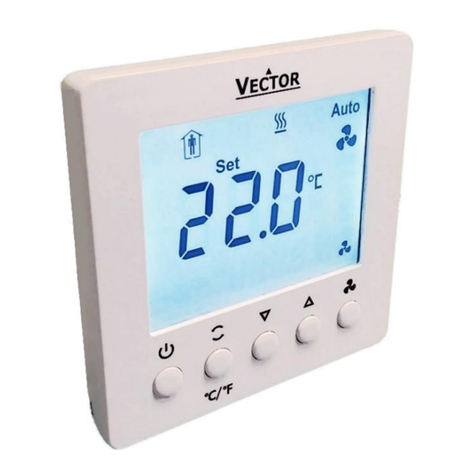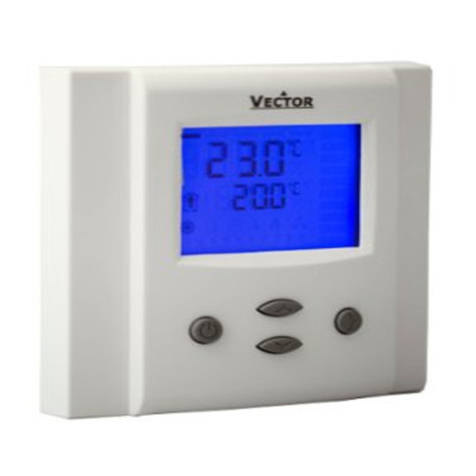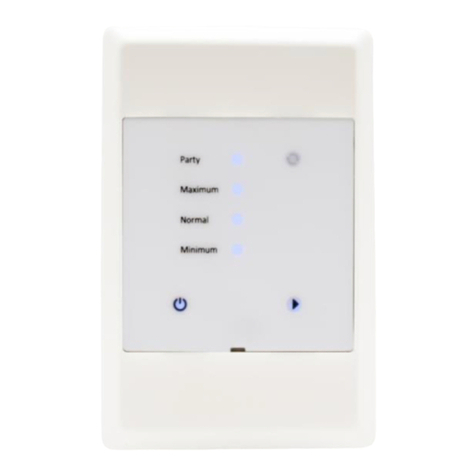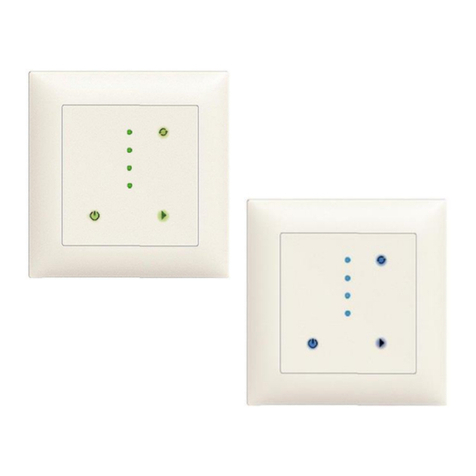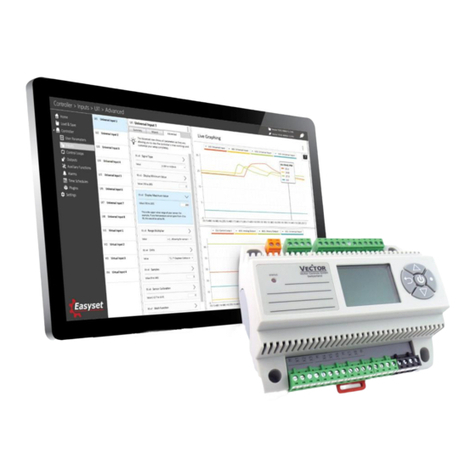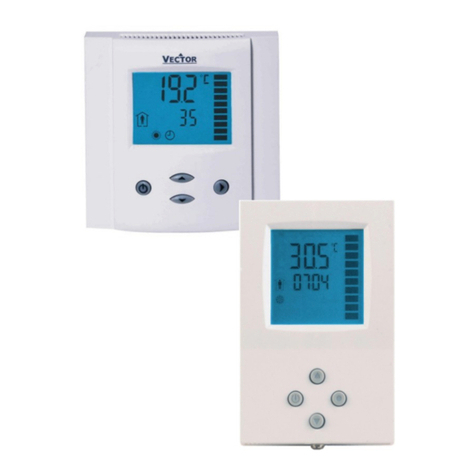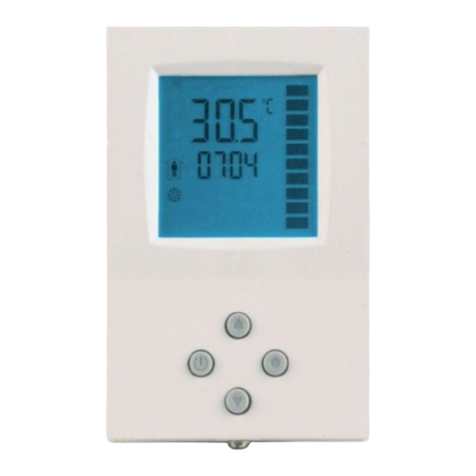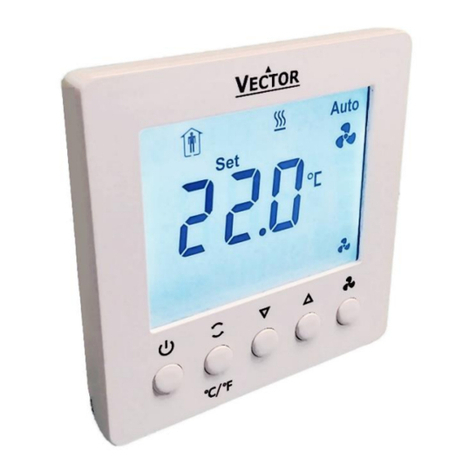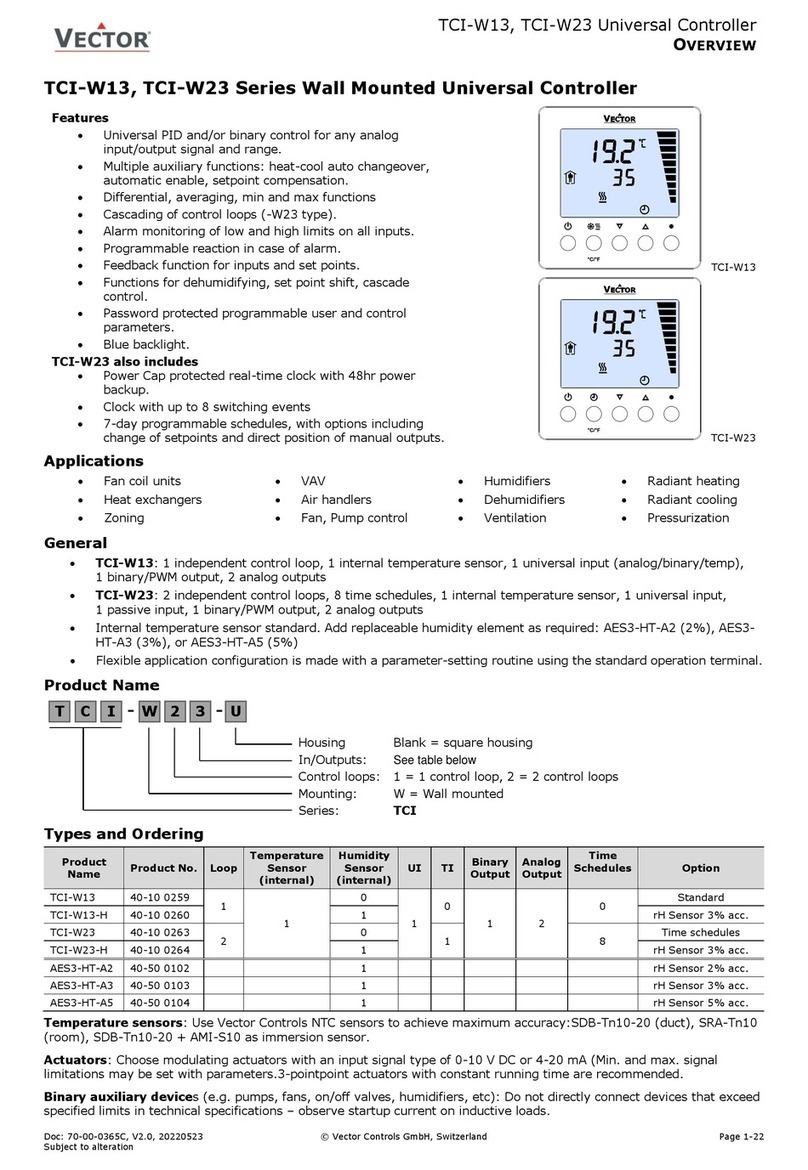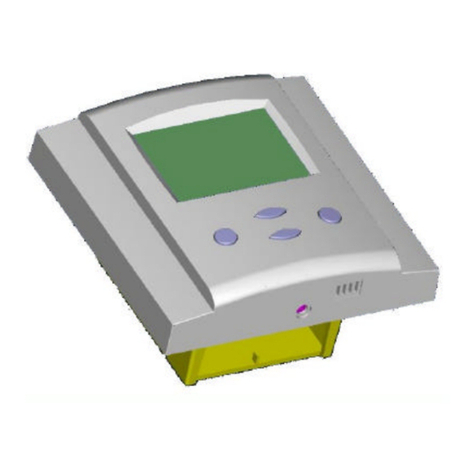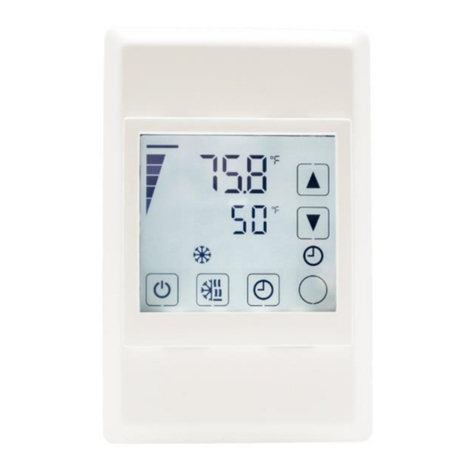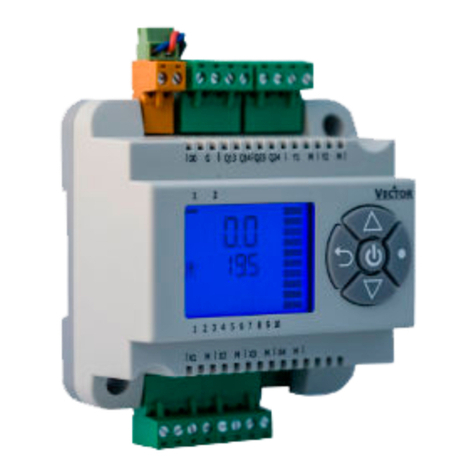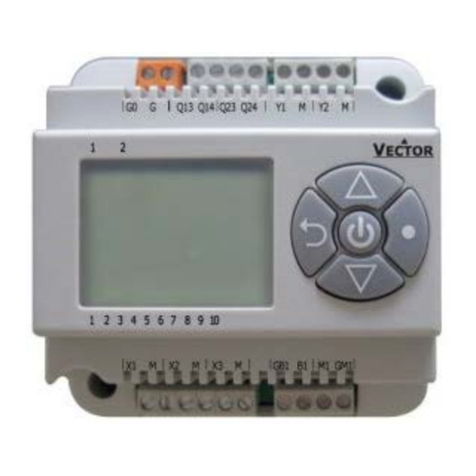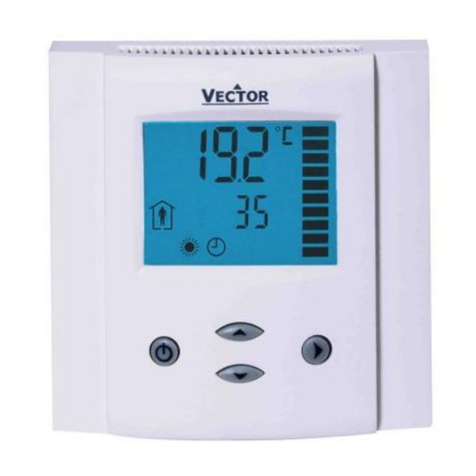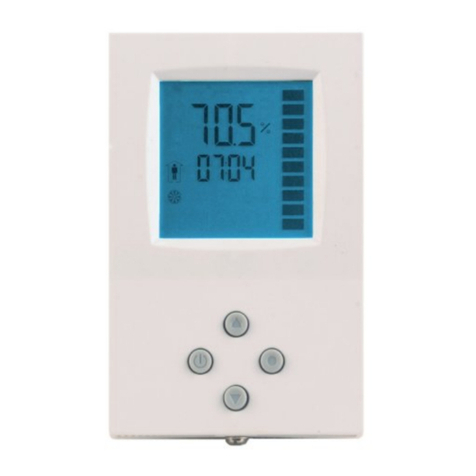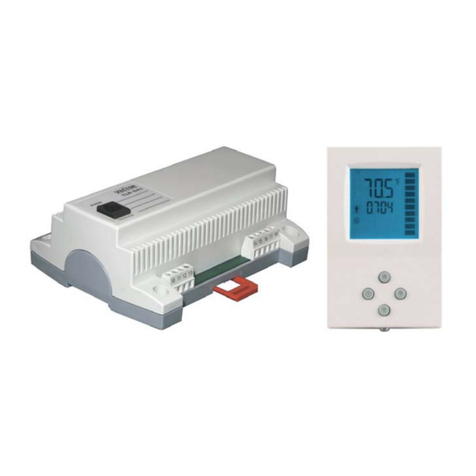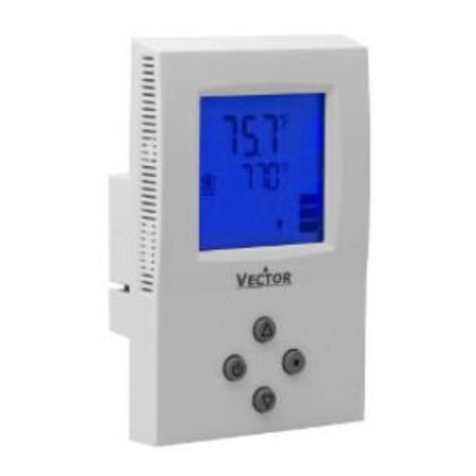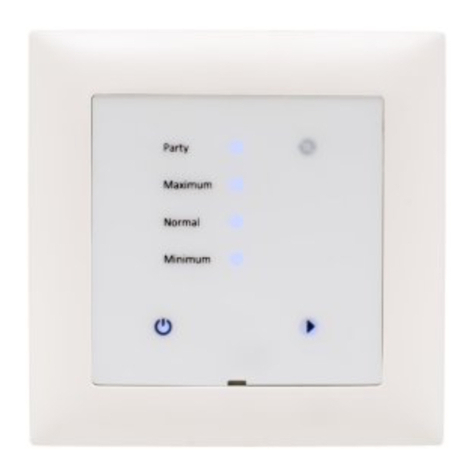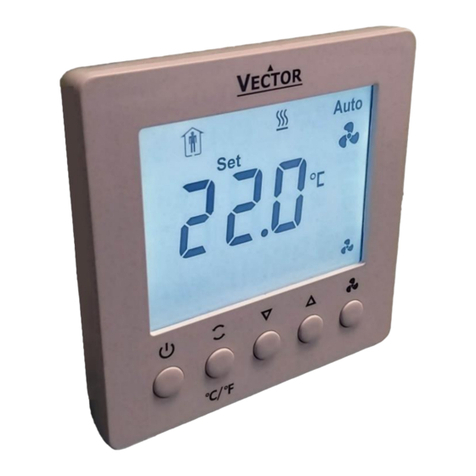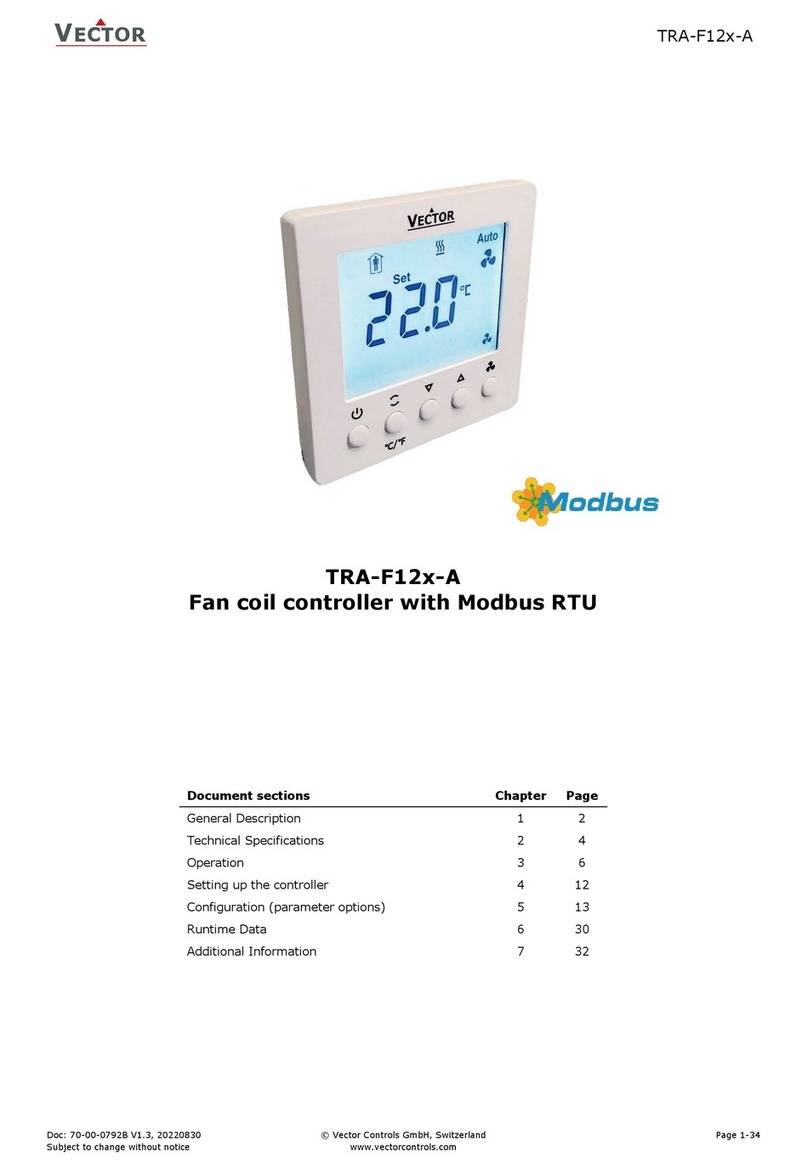
Universal controller TCI-W13-U-H/TCI-W23-U-H
Universal controller TCI-W13-U-H/TCI-W23-U-H
Universal controller TCI-W13-U-H/TCI-W23-U-H
Doc: 70-00-0384A V1.0 20160523 © Vector ControlsGmbH, Switzerland Subject to alterations
TCI-W13-U-H, TCI-W23-U-H wall mounted universal controller
with internal temperature and humidity sensor
General description
The TCI-W is a stand-alone wall mounted electronic universal controller with two autonomous control loops.
Each control loop may use up to 2 PID sequences and 6 binary sequences. The TCI-W13 features
1 independent control loop, 1 universal input, 1 binary relay output and 2 analog outputs, the TCI-W23 offers
2 independent control loops, 1 universal input, 1 passive input, 1 binary relay output and 2 analog outputs. A
detailed configuration is possible by following a simple setup routine. The TCI can be configured using the
standard operation terminal. No special tool or software is required.
Ordering, name convention
TCI-W23-U Optional functions and housing
│ │││ └───── Housing U = 2 x 4” type housing, blank = square housing
│ ││└─────── In-/outputs: 1 = 1UI, 1DOR, 2AO, 2 = 1UI, 1Passive In, 1DOR, 2AO
│ │└──────── Control loops: 1 = 1 control loop, 2 = 2 control loops
│ └───────── Mounting: W = Wall mounted
└──────────── Series indication TCI
Accessories
Selection of actuators and sensors
Temperature sensors: Use only our approved NTC sensors to achieve maximum accuracy. Recommended
is SDB-Tn10 as duct sensor, SRA-Tn10 as room sensor.
Modulating actuators: Choose actuators with an input signal type of 0...10 VDC or 4...20mA. Minimum and
maximum signal limitations may be set in software.
Binary auxiliary devices: E.g. pumps, fans, on/off valves, humidifiers, etc. Do not directly connect devices
that exceed the maximum limits asdescribed under technical data. Observe startup current on inductive
loads.
Jumper configuration
Jumpers are mounted vertically only.
1. AO - Selection of output signal type:
oLeft position: voltage output (0…10 V), factory default
oRight position: current output (0…20 mA)
2. AI - Selection of input signal type:
oLeft position: voltage input (0…10 V), factory default
oMiddle position: current input (0…20 mA)
oRight position: RT or dry-contact input
Mounting location
Install the controller on an easy accessible interior wall, approx. 1.5 m above the floor in an area of
average temperature.
Avoid direct sunlight or other heat sources, e.g. the area above radiators and heat emitting equipment.
Avoid locations behind doors, outside walls and below or above air discharge grills and diffusers.
Location of mounting is less critical if external temperature sensors are used.
Installation
1. Connect the wires to be connected to the terminals of the power case according to wiring diagram
2. Install the mounting plate to the flush mounting box. Make sure that the nipple with the front holding
screw is facing to the ground. Make sure the mounting screw heads do not stand out more than
5 mm (0.2”) off the surface of the mounting plate.
3. Ensure that the jumpers are set correctly.
4. Slide the two latches located on the top of the front part into the hooks at the upper side of the
mounting plate.
5. Carefully lower the front part until the interconnector reaches the mounting-plate. Continue
pressing in a gentle way until the front part is fully connected. While inserting the connectors, a
slight resistance can be felt. This is normal. Do not use excessive force!
6. With a Philips-type screw driver of size #2, carefully tighten the front holding screwto secure the
front part to the mounting plate. This screw is located on the front lower side of the unit. There is no
need to tighten the screw too much.
Technical specification
Warning! This device is intended to be used for comfort applications. Where a device failure endangers human life
and/or property, it is the responsibility of the owner, designer and installer to add additional safety devices to prevent
or detect a system failure caused by such a device failure. The manufacturer of this device cannot be held liable for
any damage caused by such a failure.
Failure to follow specifications and local regulations may endanger life, cause equipment damage and void warranty.
Terminal connectors,
wire 0.34…2.5 mm2(AWG 22…13)
24 hours (deluxe version only)
Analog inputs
Input signal
Resolution
Impedance
UI1, UI2
DC 0...10V or 0…20mA
39 mV or 0.078 mA
Voltage: 98kΩ current: 240Ω
Temperature inputs
Range
Resolution
Accuracy
RT internal, external (Sxx-Tn10 sensor)
Int. NTC: 0…50 °C (32…122 °F)
Ext. NTC: -40…140 °C (-40…284 °F)
0.1 K
-40…0 °C (-40…32 °F): 0.5 K
0…50 °C (32…122 °F): 0.2 K
50…100 °C (122…212 °F): 0.5 K
> 100 °C (> 212 °F): 1 K
Humidity sensor AES-HT-Ax:
Range
Measuring accuracy
Hysteresis
Repeatability
Stability
Capacity sensor
0…100% RH
See figure below
1%
0.1%
< 0.5% / year
Analog outputs
Output signal
Resolution
Maximum load
AO1
DC 0...10V or 0…20mA
39 mV, 0.078 mA
Voltage: ≥5kΩ current: ≤250Ω
Relays outputs
Type of disconnection
AC voltage
DC voltage
Micro-interruption
0…48 VAC, 2(1.2)A max. Observe local regulations
0…30 VDC, 2A max.
Insulation strength
between relays contacts and system
electronics:
Operation
Climatic conditions
Temperature
Humidity
To IEC 721-3-3
class 3K5
0…50 °C (32…122 °F)
<95% RH non-condensing
Transport & Storage
Climatic conditions
Temperature
Humidity
Mechanical conditions
To IEC 721-3-2 and IEC 721-3-1
class 3K3 and class 1K3
-25…70 °C (-13…158 °F)
<95%RH non-condensing
class 2M2
conform according to
EMC Standard
EMEI Standard 73/23/EEC
EN 61000-6-1/ EN 61000-6-3
Product standards
Automatic electrical controls for
household and similar use
special requirement on temperature
dependent controls
II (IEC 60536) if voltage on DO > 48V
III (IEC 60536) if voltage on DO < 48V
Materials: Cover, back part
Mounting plate
Fire proof ABS plastic (UL94 class V-0)
Galvanized Steel
Front part: 112 x 73 x 15 mm (4.4” x 2.9” x 0.6”)
Power case: ø 58 x 32 mm (ø 2.3” x 1.3”)
Weight (including package)
TCI-W13-U-H = 260g (8.1 oz)
TCI-W23-U-H = 270g (9.5 oz)
Power failure
Upon power-interruption, all parameters and set points
are memorized in non-volatile memory, and therefore
do not have to be re-entered.
Error messages
Err1: An assigned input is not enabled or
missing. All control loops, functions and
outputs tied to this input will be disabled.
Verify input connections, jumper
settings and parameter settings for the
input involved.
Err3: A function refers to a disabled input.
Disable the function or enable the input.
Err4: Internal failure. Product must be replaced.
Wiring diagram
Warning: Live electrical components!
During installation, testing, servicing and troubleshooting of Vector Controls products, it may be necessary to
work with live electrical components. Have a qualified licensed electrician or other individual who has been
properly trained in handling live electrical components perform these tasks. Failure to follow all electrical
safety precautions when exposed to live electrical components could result in death or serious injury.
Description
G0 Power supply: 0V, -24VDC; common for power supply, analog in- and outputs
G Power supply: 24VAC, +24VDC
XU1 Universal input: NTC 10kΩ @ 25°C (77 °F) or open contact,
0…10VDC or 0…20 mA (selectable by jumper)
XT2 Passive input: NTC 10kΩ @ 25°C (77 °F) or open contact
YB1 Binary output: Potential free relays contacts (see technical specification)
YM1, XM2 Analog outputs: 0…10 V or 0…20 mA (selectable by jumper)
XT1 Internal temperature input
XH1 Internal humidity input if AES-HT is inserted
Dimensions mm (inch)
Figure 1: Max RH-tolerance at 25 °C (77 °F) per
sensor type
Relative humidity accuracy
